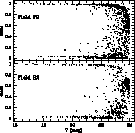

Up: The central region of
The separation of resolved (= galaxies) and unresolved (= stars, globular
clusters, and
unresolved background galaxies) was done with the "star/galaxy classifier''
developed by Bertin & Arnouts (1996). It is a neural
network trained program
that classifies each object with a "stellarity index'' between 0 (galaxy) and
1 (point source).
In all fields the separation works fine down to a V magnitude of 21 mag.
Beyond this magnitude the classifier values start to scatter.
Figure 2 shows as an example the classifier versus V magnitude
plots for the NE field (F2) of NGC 1399 and the background field B2. Eye
control in all fields showed that all objects with classifier
values below 0.35 are well resolved objects, whereas objects above this
value can not be clearly classified.
 |
Figure 2:
The classifier value (0 = galaxy, 1 = point source) is plotted
versus
the V magnitude for two different CCD fields (see Fig. 1). For
V<21 the seperation of point sources and galaxies is obvious. For fainter
magnitudes all objects with classifier values below 0.35 ihave been
identified as well resolved.
Note that most point sources in field F1 are globular clusters that belong to
the central galaxy NGC 1399 |
Therefore all objects were selected that have classifier
values below 0.35.
Down to a  and 23.0 mag we found 873 and 1775 galaxies
respectively.
The properties of all galaxies brighter than 22.0 mag are compiled in a
catalog, see Appendix A. This cutoff in the final sample was chosen
for several reasons: the finding completeness starts to drop, the scatter in
the classifier values increases significantly. Also, at this magnitude we
would not find any dEs that follow the
surface brightness - magnitude
relation of Local Group or Virgo dwarf spheroidals
(e.g. Kormendy 1985; Binggeli 1994) due
to the limit in surface brightness. See Sect. 7 for a discussion of the
completeness of dwarf galaxies in the Fornax distance.
and 23.0 mag we found 873 and 1775 galaxies
respectively.
The properties of all galaxies brighter than 22.0 mag are compiled in a
catalog, see Appendix A. This cutoff in the final sample was chosen
for several reasons: the finding completeness starts to drop, the scatter in
the classifier values increases significantly. Also, at this magnitude we
would not find any dEs that follow the
surface brightness - magnitude
relation of Local Group or Virgo dwarf spheroidals
(e.g. Kormendy 1985; Binggeli 1994) due
to the limit in surface brightness. See Sect. 7 for a discussion of the
completeness of dwarf galaxies in the Fornax distance.
In the background fields B3 and B4 we found with the same selection criteria
668 and 1022 down to V = 22.0 mag respectively.
However, one has to be careful when comparing these results with those
of the other CCD fields.
The pixel size is about 3 times larger than in the first run leading to
a 9 times higher area covered by each pixel. We simulated this resolution for
two fields of our first run by binning  pixel and run SExtractor
again. On the one hand, some galaxies have been classified as point sources due
to their small angular sizes below the "new'' resolution. On the other hand,
some new "galaxies'' have been gained due to the overlap of objects very close
in the high resolution image. Down to our magnitude limit of V = 22.0
mag loss and gain of galaxies are nearly balanced and in the order of 8% of
the total galaxy counts.
pixel and run SExtractor
again. On the one hand, some galaxies have been classified as point sources due
to their small angular sizes below the "new'' resolution. On the other hand,
some new "galaxies'' have been gained due to the overlap of objects very close
in the high resolution image. Down to our magnitude limit of V = 22.0
mag loss and gain of galaxies are nearly balanced and in the order of 8% of
the total galaxy counts.


Up: The central region of
Copyright The European Southern Observatory (ESO)
